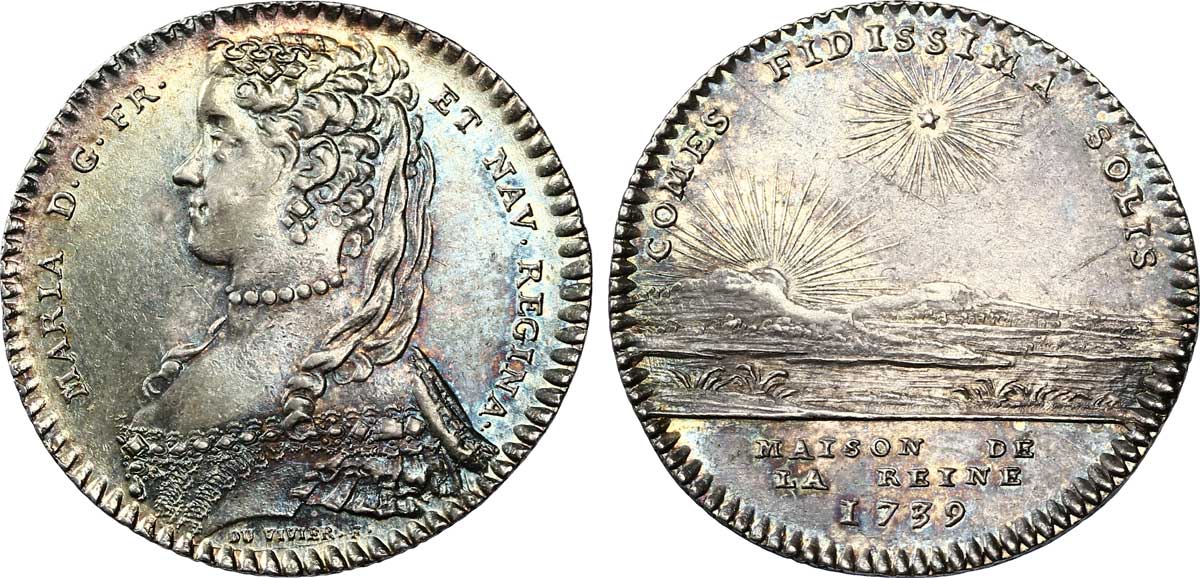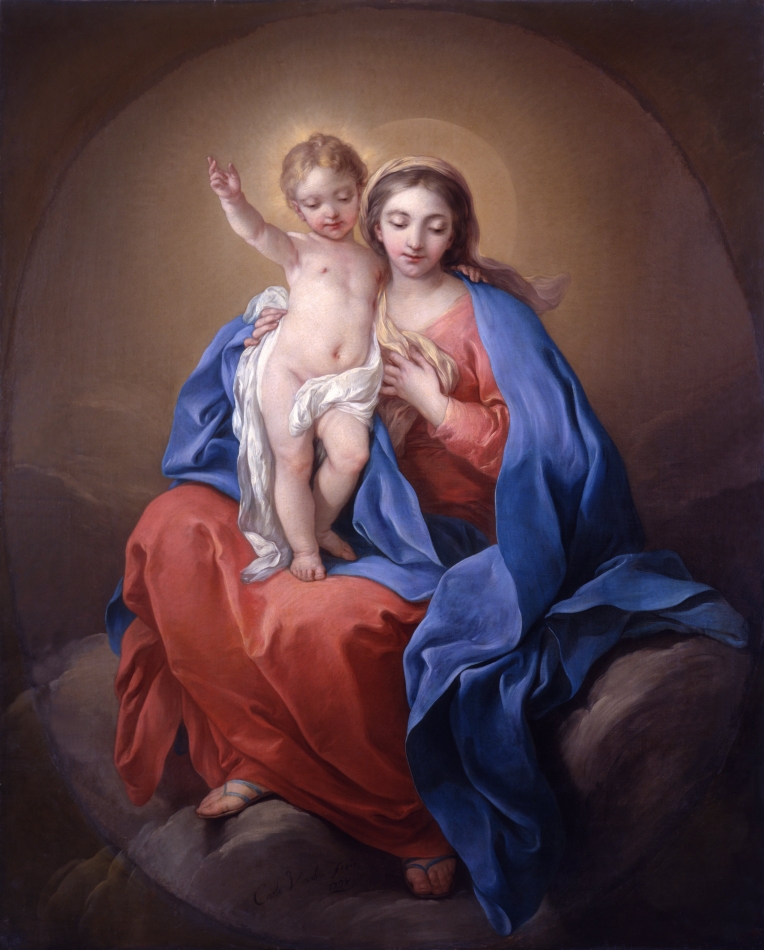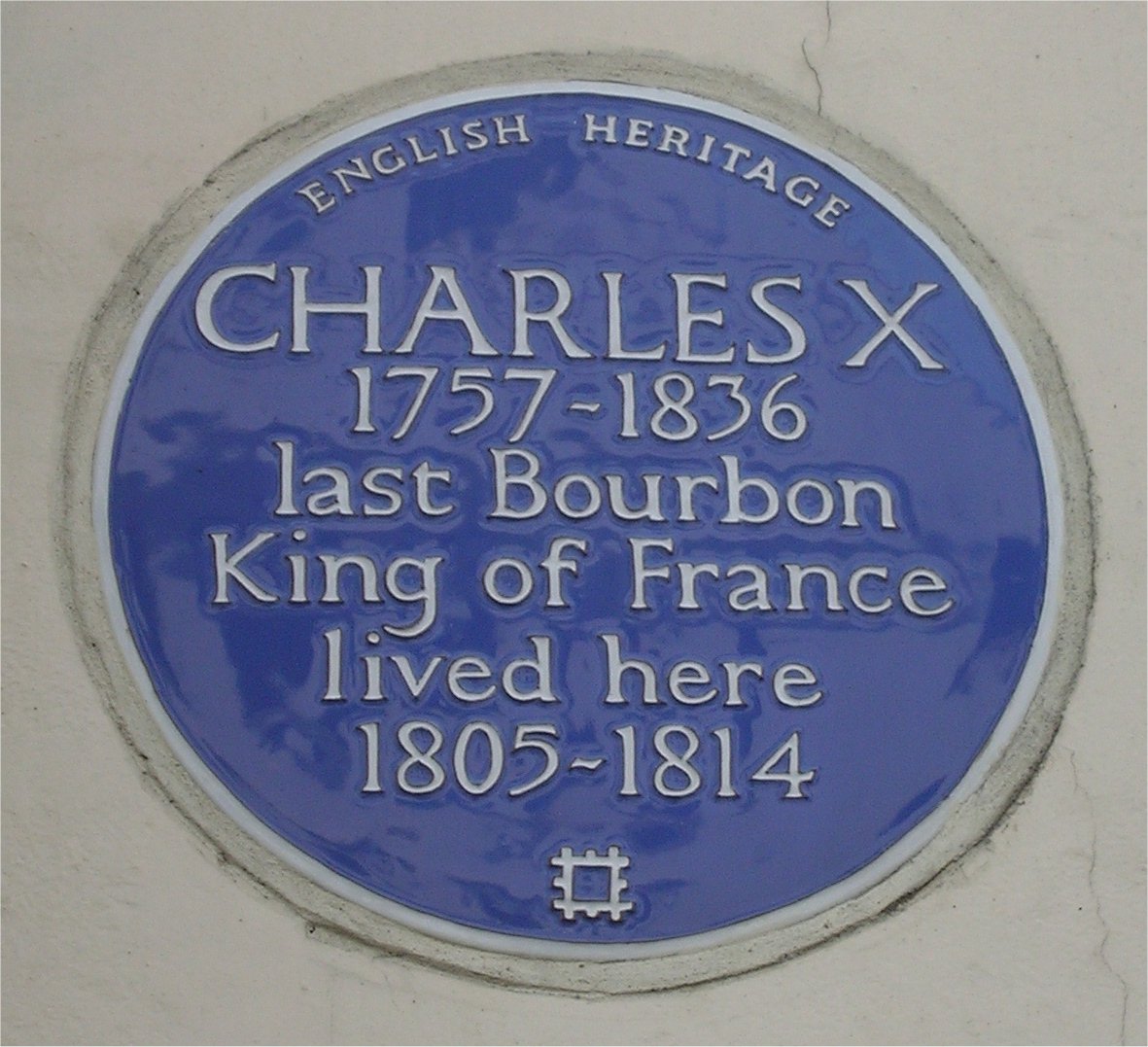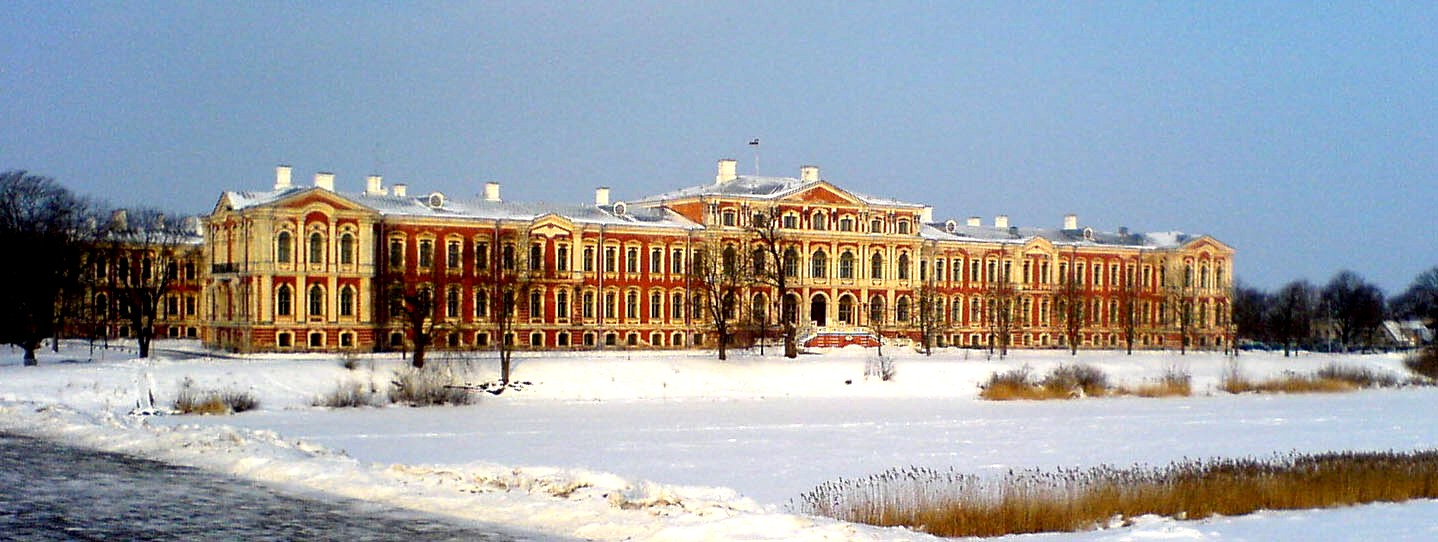|
Marie Leszczyńska
Maria Karolina Zofia Felicja Leszczyńska (; 23 June 1703 – 24 June 1768), also known as Marie Leczinska (), was Queen of France as the wife of King Louis XV from their marriage on 4 September 1725 until her death in 1768. The daughter of Stanislaus I Leszczyński, the deposed King of Poland, and Catherine Opalińska, her 42-years and 9 months service was the longest of any queen in French history. A devout Catholic throughout her life, Marie was popular among the French people for her numerous charitable works and introduced many Polish customs to the royal court at Palace of Versailles, Versailles. She was the grandmother of the French kings Louis XVI, Louis XVIII and Charles X of France, Charles X. Early life Born as a member of the Leszczyński, House of Leszczyński, Maria Karolina Zofia Felicja Leszczyńska (Wieniawa coat of arms, Wieniawa) was the second daughter of Stanislaus I Leszczyński and his wife, Catherine Opalińska, Countess Catherine Opaliński family, Opal ... [...More Info...] [...Related Items...] OR: [Wikipedia] [Google] [Baidu] |
Victoire Of France
Victoire of France (Marie Louise Thérèse Victoire; 11 May 1733 – 7 June 1799) was a French princess, the daughter of King Louis XV and the popular Queen Marie Leszczyńska. She was named after her parents and Queen Maria Theresa, her great-great-grandmother and the consort of Louis XIV of France. Originally known as ''Madame Quatrième'', signifying the fourth daughter of the King (an older sister, Marie Louise, had died in February 1733, before her birth), she was later known as ''Madame Victoire''. She outlived eight of her nine siblings, and was survived by her older sister Madame Adélaïde by less than a year. The sisters were collectively known as '' Mesdames''. Life Early years Princess Victoire was born at the Palace of Versailles on 11 May 1733. She was the seventh child and fifth daughter of King Louis XV of France and Queen Maria Leszczyńska. Unlike the older children of Louis XV, Madame Victoire was not raised at the Palace of Versailles. Rather ... [...More Info...] [...Related Items...] OR: [Wikipedia] [Google] [Baidu] |
Charles-André Van Loo
Carle or Charles-André van Loo (; 15 February 1705 – 15 July 1765) was a French painter, son of the painter Louis-Abraham van Loo, a younger brother of Jean-Baptiste van Loo and grandson of Jacob van Loo. He was the most famous member of a successful dynasty of painters of Dutch origin. His oeuvre includes every category: religion, history painting, mythology, portraiture, allegory, and genre scenes. Life He was born in Nice, then part of the Savoyard state. Van Loo followed his brother Jean-Baptiste to Turin, and then to Rome in 1712, where he studied under Benedetto Luti and the sculptor Pierre Le Gros. After leaving Italy in 1723, he worked in Paris, studied at the Académie royale de peinture et de sculpture, where he gained first prize for drawing in 1723, and received the first prize for historical painting in 1727—as did his future rival François Boucher. In 1724 he won the Prix de Rome. After again visiting Turin in 1727, he was employed by King Victor Amadeus ... [...More Info...] [...Related Items...] OR: [Wikipedia] [Google] [Baidu] |
House Of Leszczyński
A house is a single-unit residential building. It may range in complexity from a rudimentary hut to a complex structure of wood, masonry, concrete or other material, outfitted with plumbing, electrical, and heating, ventilation, and air conditioning systems.Schoenauer, Norbert (2000). ''6,000 Years of Housing'' (rev. ed.) (New York: W.W. Norton & Company). Houses use a range of different roofing systems to keep precipitation such as rain from getting into the dwelling space. Houses generally have doors or locks to secure the dwelling space and protect its inhabitants and contents from burglars or other trespassers. Most conventional modern houses in Western cultures will contain one or more bedrooms and bathrooms, a kitchen or cooking area, and a living room. A house may have a separate dining room, or the eating area may be integrated into the kitchen or another room. Some large houses in North America have a recreation room. In traditional agriculture-oriented societ ... [...More Info...] [...Related Items...] OR: [Wikipedia] [Google] [Baidu] |
Leszczyński
The House of Leszczyński ( , ; plural: Leszczyńscy, feminine form: Leszczyńska) was a prominent Polish noble family. They were magnates in the Polish–Lithuanian Commonwealth and later became the royal family of Poland. History The Leszczyński family was a magnate family. In 1473, Rafał Leszczyński obtained from Emperor Frederick III the title of count. This title was conferred on "the entire family". The last representative of the main family, Stanisław Leszczyński, King of Poland, Grand Duke of Lithuania and later Duke of Lorraine, died in 1766. The family name derives from Leszczyna, now a suburb of Leszno, Greater Poland. The Leszczyński family obtained the title of count of Leszno in the Holy Roman Empire. The family had its greatest importance in the late 16th and early 17th centuries, when they were ardent supporters of Calvinism and turned their estates of Leszno and Baranów Sandomierski into major centres of the Polish Reformed Church. There is another u ... [...More Info...] [...Related Items...] OR: [Wikipedia] [Google] [Baidu] |
Charles X Of France
Charles X (Charles Philippe; 9 October 1757 – 6 November 1836) was King of France from 16 September 1824 until 2 August 1830. An uncle of the uncrowned Louis XVII and younger brother of reigning kings Louis XVI and Louis XVIII, he supported the latter in exile. After the Bourbon Restoration in France, Bourbon Restoration in 1814, Charles (as heir-presumptive) became the leader of the ultra-royalists, a radical monarchist faction within the French court that affirmed absolute monarchy by Divine Right of Kings, divine right and opposed the constitutional monarchy concessions towards Classical liberalism, liberals and the guarantees of civil liberties granted by the Charter of 1814. Charles gained influence within the French court after the assassination of his son Charles Ferdinand, Duke of Berry, in 1820 and succeeded his brother Louis XVIII in 1824. Charles's reign of almost six years proved to be deeply unpopular amongst the liberals in France from the moment of Coronation of ... [...More Info...] [...Related Items...] OR: [Wikipedia] [Google] [Baidu] |
Louis XVIII
Louis XVIII (Louis Stanislas Xavier; 17 November 1755 – 16 September 1824), known as the Desired (), was King of France from 1814 to 1824, except for a brief interruption during the Hundred Days in 1815. Before his reign, he spent 23 years in exile from France beginning in 1791, during the French Revolution and the First French Empire. Until his accession to the throne of France, he held the title of Count of Provence as brother of King Louis XVI, the last king of the ''Ancien Régime''. On 21 September 1792, the National Convention abolished the monarchy and deposed Louis XVI, who was later Execution of Louis XVI, executed by guillotine. When his young nephew Louis XVII died in prison in June 1795, the Count of Provence claimed the throne as Louis XVIII. Following the French Revolution and during the Napoleonic era, Louis XVIII lived in exile in Kingdom of Prussia, Prussia, Kingdom of Great Britain, Great Britain, and Russian Empire, Russia. When the War of the Sixth ... [...More Info...] [...Related Items...] OR: [Wikipedia] [Google] [Baidu] |
Louis XVI
Louis XVI (Louis-Auguste; ; 23 August 1754 – 21 January 1793) was the last king of France before the fall of the monarchy during the French Revolution. The son of Louis, Dauphin of France (1729–1765), Louis, Dauphin of France (son and heir-apparent of Louis XV, King Louis XV), and Maria Josepha of Saxony, Dauphine of France, Maria Josepha of Saxony, Louis became the new Dauphin of France, Dauphin when his father died in 1765. In 1770, he married Marie Antoinette. He became King of France and Navarre on his grandfather's death on 10 May 1774, and reigned until the proclamation of the abolition of the monarchy, abolition of the monarchy on 21 September 1792. From 1791 onwards, he used the style of king of the French. The first part of Louis XVI's reign was marked by attempts to reform the French government in accordance with Enlightened absolutism, Enlightenment ideas. These included efforts to increase Edict of Versailles, tolerance toward non-Catholics as well as abolishing ... [...More Info...] [...Related Items...] OR: [Wikipedia] [Google] [Baidu] |
Catholic
The Catholic Church (), also known as the Roman Catholic Church, is the List of Christian denominations by number of members, largest Christian church, with 1.27 to 1.41 billion baptized Catholics Catholic Church by country, worldwide as of 2025. It is among the world's oldest and largest international institutions and has played a prominent role in the history and development of Western civilization.Gerald O'Collins, O'Collins, p. v (preface). The church consists of 24 Catholic particular churches and liturgical rites#Churches, ''sui iuris'' (autonomous) churches, including the Latin Church and 23 Eastern Catholic Churches, which comprise almost 3,500 dioceses and Eparchy, eparchies List of Catholic dioceses (structured view), around the world, each overseen by one or more Bishops in the Catholic Church, bishops. The pope, who is the bishop of Rome, is the Papal supremacy, chief pastor of the church. The core beliefs of Catholicism are found in the Nicene Creed. The ... [...More Info...] [...Related Items...] OR: [Wikipedia] [Google] [Baidu] |
King Of Poland
Poland was ruled at various times either by dukes and princes (10th to 14th centuries) or by kings (11th to 18th centuries). During the latter period, a tradition of Royal elections in Poland, free election of monarchs made it a uniquely electable position in Europe (16th to 18th centuries). The first Polish ruler whose existence is not debatable was Mieszko I, Duke Mieszko I, who Christianization of Poland, adopted Christianity under the authority of Rome in the year 966. He was succeeded by his son, Bolesław I the Brave, who greatly expanded the boundaries of the Polish state and ruled as the first king in 1025. The following centuries gave rise to the mighty Piast dynasty, consisting of both kings such as Mieszko II Lambert, Przemysł II or Władysław I the Elbow-high and dukes like Bolesław III Wrymouth. The dynasty's rule over Poland ceased with the death of Casimir III the Great in 1370. In the same year, the Capetian House of Anjou became the ruling house with Louis I t ... [...More Info...] [...Related Items...] OR: [Wikipedia] [Google] [Baidu] |
Queen Of France
This is a list of the women who were queens or empresses as wives of French monarchs from the 843 Treaty of Verdun, which gave rise to West Francia, until 1870, when the French Third Republic was declared. Living wives of reigning monarchs technically became queen consorts, including Margaret of Burgundy and Blanche of Burgundy who were kept in prison during their whole queenships. Carolingian dynasty (751-987) Capetian dynasty (987-1792, 1814-1815, 1815-1848) Direct Capetians (987-1328) House of Valois (1328-1589) House of Lancaster Some sources refer to Margaret of Anjou as Queen of France,Mary Ann Hookham: "The life and times of Margaret of Anjou, queen of England and France ", 1872 but her right to enjoy that title is disputed. She was briefly recognized only in English-controlled territories of France. (See also: Dual monarchy of England and France) Capetian dynasty House of Valois House of Bourbon (1589-1792) Françoise d'Aubigné, Marquise de M ... [...More Info...] [...Related Items...] OR: [Wikipedia] [Google] [Baidu] |
Royal And Noble Styles
Styles represent the fashion by which monarchs and noblemen are properly addressed. Throughout history, many different styles were used, with little standardization. This page will detail the various styles used by royalty and nobility in Europe, in the final form arrived at in the nineteenth century. Imperial, royal, and princely styles Only those classified within the social class of royalty and upper nobility have a style of "Highness" attached before their titles. Reigning bearers of forms of Highness included grand princes, grand dukes, reigning princes, reigning dukes, and princely counts, their families, and the agnatic (of the male bloodline) descendants of emperors and kings. Royalty (usually emperors to princely counts) are all considered sovereign princes (). *Emperors and empresses held the style of Imperial Majesty (HIM). *Members of imperial families generally hold the style of Imperial Highness (HIH). *In the Austrian Empire, the Emperor was also the King of Hun ... [...More Info...] [...Related Items...] OR: [Wikipedia] [Google] [Baidu] |








